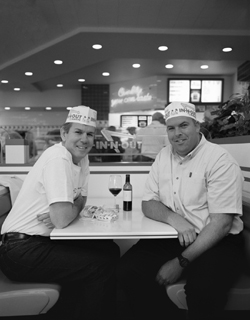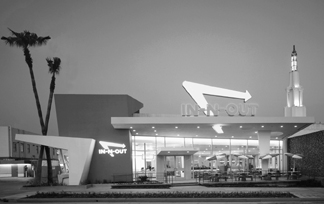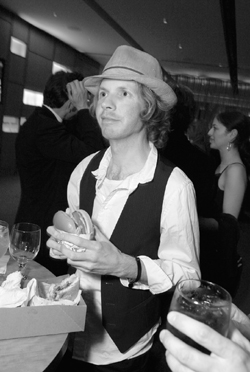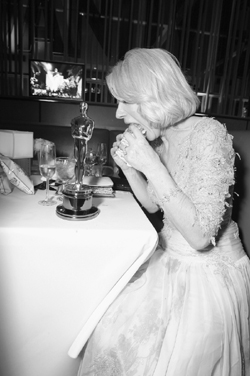In-N-Out Burger (15 page)
Authors: Stacy Perman


MICHELIN-STARRED FAN:
The French Laundry's renowned chef Thomas Keller (left) was photographed in the Napa Valley In-N-Out store for the April 2006 issue of
Food
&
Wine
magazine. A longtime (and vocal) fan of the chain, Keller announced he was opening his own burger restaurant, Burgers and Half-Bottles, an homage of sorts to In-N-Out. (
Thomas Heinser
)

BREAKOUT DESIGN:
The Westwood In-N-Out, store 119, was designed by famed Los Angeles architect Stephen Kanner in the pop modern style in 1997. Kanner's hopes to leverage his award-winning design to re-brand the chain going forward were dashed when he was told “The burgers should be the star,” not the store. (
Kanner Architects
)

IN-N-OUT AT THE OSCARS:
Since 2001,
Vanity Fair
editor Graydon Carter has hired one of the chain's cookout trailers for his annual party at Morton's following the Academy Awards. Wildly popular, the iconic burgers have become an integral part of the exclusive fete. At the 2006 party, alternative rocker Beck grabs a cheeseburger. (
Eric Charbonneau/Wireimages Getty Images
)

THE QUEEN:
Celebrated actress Helen Mirren in her custom-made Christian Lacroix gown was famously photographed tucking into an In-N-Out burger following her best actress win at
Vanity Fair
's 2007 party. (
Eric Charbonneau/Wireimages Getty Images
)
After courting for a year and a half the pair married in 1981. However, Rich insisted that his brother have a prenuptial agreement signed before the wedding could take place. Just two days before the wedding, Kim Stites ran into Lynda, who appeared irritated by the prospect. “She wasn't happy about the prenuptial,” Stites recalled. Nevertheless, Lynda apparently signed it, as the event moved forward.
Their wedding on Valentine's Day was a lavish affair held at the Crystal Cathedral in Garden Grove. The Philip Johnsonâdesigned church took its name from the more than ten thousand rectangular panes of silver glass that housed the cathedral. The new Mr. and Mrs. Snyder began their marriage in high style; a helicopter flew the couple to their reception aboard the
Queen Mary
, the luxury liner that had once ferried Winston Churchill, Marlene Dietrich, Clark Gable, and Fred Astaire across the Atlantic.
By all accounts, Guy transitioned easily from a thirty-year-old bachelor to a husband with a ready-made family, quickly embracing his two new stepdaughters. Said one relative, “He loved those girls like his own.” The couple lived in a $600,000 estate home in Glendora, nestled in the bluffs at the foot of the San Gabriel Mountains. The couple divided their time between Glendora and their 170-acre ranch in the picturesque mountain wilderness of Shasta County at the northern ridge of the Sacramento Valley. Up at the Flying Dutchman Ranch (named in homage to his father Harry's ancestry), Guy liked to ride his Caterpillar tractor across the property, play video games, engage in paintball matches, and shoot off pistols. In the summers, he went fishing in Alaska or hunting in Montana. Lynda began raising llamas.
Guy was not completely absent from In-N-Out; he was involved to a degree with the warehouse and meat department. Along with Lynda, he attended many of the company's events and activitiesâbut there was no question that it was Rich who was in charge at In-N-Out Burger.
On May 5, 1982, Lynda gave birth to the couple's first childâa daughter, Lynsi Lavella Snyder. She was Guy's only biological child, and he doted on his new daughter. It appeared that, despite his recurrent troubles, Guy had found a measure of stability in his life.
Rich's tastes ran contrary to those of his parochial parents. He had no problem spending extravagantly and often turned the most basic of events into glittering, over-the-top affairs. Straightlaced in practically every other area of his life, his prolific spending stemmed from his belief that In-N-Out was not just a fast-food jointâand Rich's predilection for the showy was his way of broadcasting this belief.
In January 1979, Rich hired a local architect to work with him on designing an entirely new headquarters and warehouse on the original property on East Virginia Avenue. In rebuilding the facility, Rich decided to erect a structure that would incorporate the practicalities needed for the growing company he envisioned and at the same time embody Rich's lofty ambitions. When it was finished, it resembled one of the mansions of the captains of industry rather than the offices of a modest Depression-era couple who founded a postwar burger joint.
Construction crews broke ground in Baldwin Park in 1979, and by the time In-N-Out Burger's sprawling nine-acre complex was finished almost two years later, the chain had expanded to twenty-four shops. On December 1, 1981, In-N-Out's corporate office personnel moved in, signaling a new era for the small burger chain.
It was a time of dynamic changes. Just eleven months earlier, former movie star and governor of California Ronald Reagan was inau
gurated as the fortieth president of the United States. The Republican administration marked a new era of conservative politics and economics. The national news was focused on the new president's supply-side economic policy (called “Reaganomics”); the end of détente with the Soviet Union; and the start of a massive military buildup.
On the cultural front, a new nighttime soap opera revolving around a fictional wealthy oil family from Denver called
Dynasty
made its debut. MTV, the twenty-four-hour music video channel launched on cable. And a shy, twenty-year-old kindergarten teacher named Lady Diana Spencer became an instant global phenomenon when she married Britain's Prince Charles on July 29, 1981. Their wedding attracted 750 million television viewers in sixty-one countries.
The timing was perfect. The new In-N-Out headquarters' ribbon-cutting ceremony took place just as the San Gabriel Valley was on the cusp of experiencing tremendous economic growth. Baldwin Park's chamber of commerce began actively recruiting new businesses and redevelopment projects. A newly built two-bedroom house with two bathrooms cost about $80,000âa tenfold increase from the time when Esther and Harry first arrived.
Â
Located among gritty industrial factories and lumberyards, In-N-Out Burger's new complex ran along both sides of East Virginia Avenue, encircled by a sentry of long-necked palm trees, securely locked behind gates. The headquarters' showpiece was its two-story villa, modeled after one of the many grand Spanish mission-style revival villas that had once graced the San Gabriel Valley. It featured stucco walls, terra-cotta roofing, arched windows and doorways, hand-carved woodwork, vintage tiled ceilings, and wrought-iron ornamentation. A custom-made stone fountain was flown in from Guadalajara, Mexico. Rising above the villa was a custom-made cupola with a twelve-foot diameter and a five-foot drop. Inside the corporate offices, a large portrait of Harry Snyder was hung.
Instead of asphalt, Rich chose to lay down costly poured concrete. Custom landscaping brightened up the islands of concrete. Manicured
lawns were planted, as were beds of flowers, and dense hedges were trimmed to spell out in block letters “IN-N-OUT.” In a nod to the chain's origins, the original red and white neon sign from the first stand that read “IN-N-OUT HAMBURGERS NO DELAY” was posted on a patch of grass outside of the villa not far from the entrance gate.
Inside, the first floor was made up of several departments and rooms including the automotive department that handled all of the administrative aspects of operating the chain's growing fleet of eighteen-wheelers, maintained at the chain's truck depot that flanked the headquarters. In the “Liberty Room,” used for managers' meetings and social functions, there was an antique oak bar, built by the Brunswick Company (the manufacturer of the famed billiard tables) in 1887. According to a detailed company inventory, the ground-floor accounting department was built with a vault that held the company's “pertinent records and in-house computer,” where the temperature was maintained at a constant sixty-five to sixty-eight degrees.
A custom-made staircase with handmade railing and turnings bridged the second-floor executive offices, separated by antique doors imported from Spain. The suite's ceilings were made of lighted stained glass. Rich had the largest of the offices. A voracious reader of politics, his workspace was filled with shelves lined with books and decorated with an eclectic assortment of mementos such as his coin collection, photographs of various Republican apparatchiks, and Rich's prized 1944 Wurlitzer jukebox. Although he was rarely there, Guy had an office on the second floor, too. Smaller then Rich's, Guy's office was filled with mounted fish and game as well as drag racing memorabilia. Sumptuous and decidedly feminine, Esther Snyder's office was decorated with a suite of antique Louis XIV furniture more in keeping with Rich's idea of the kind of office that Esther should have rather than what she herself might have designed. In fact, she was hardly ever found behind her second-floor desk. Most of the time, Esther was downstairs with her sleeves rolled up, working among the cubicles in accounting.
When it came to rebuilding the warehouse, meat department, and other ancillary facilities, Rich had very specific ideas that built
on Harry's original concept of total quality control. The function of the new warehouse remained the same (it would still receive, store, and ship food supplies to the stores), but it performed on a larger scale. For instance, In-N-Out retained a potato buyer whose job it was to select the proper quality potatoes for the chain's fries.
However, if anything paid homage to the ideals of Harry Snyder and In-N-Out's unwavering commitment to freshness and quality control, it was the new warehouse and meat department. Rich exhaustively researched slaughterhouses and meat processing plants around the country for best practices before constructing the new processing center (crowned with a Spanish mission-style bell tower) that operated seven days a week.
Inside, specially selected cow and steer chucks arrived at the antiseptically clean commissary. The chain proudly proclaimed that it paid “a premium to purchase fresh, high-quality beef chucks.” And it required all of its beef suppliers to sign a purchase specification agreement prohibiting them from using “downer” (non-ambulatory) cattle. To better enforce In-N-Out's quality standards, each chuck was inspected before being accepted.
*
After In-N-Out's inspection, a team of skilled butchers boned and removed the meat. A blend of the meat was then put through a double-grinderâwith the first mill breaking it down and the second readying the beef for five special machines that molded the beef into patties at a rate of twelve hundred patties per minute. Boxed and loaded into In-N-Out's refrigerated trucks, the finished patties were then sent off to the drive-throughs. In spring 1984, the
San Gabriel Valley Tribune
reported that the family-owned chain was selling more than 14 million burgers each year.
Five years after the rebuild, having grown to thirty-two stores (with thirteen more set to open), Rich needed to enlarge and update
the warehouse again. Roughly two dozen local business executives and a handful of Baldwin Park city council members attended the ground breaking of the new $3 million facility. The
San Gabriel Valley Tribune
featured the event in its February 11, 1986, edition with a large photograph showing Rich Snyder and four city councilmen (all in suits, ties, and hard hats) on-site.
By 1990, Rich had once again doubled the size of the chain; there were now sixty-four restaurants. In-N-Out's growing critical mass (and continued profitability and popularity) spurred analysts to estimate the private company's sales.
Nation's Restaurant News
reported that In-N-Out was generating roughly $60 million in sales annually. However, Technomic Inc., a Chicago-based restaurant consultancy that published a series of industry surveys, put the figure closer to $73 million.
From the very beginning, it had been the Snyders' policy not to divulge the company's numbers. They ignored all requests to do so, regularly frustrating the financial community. As Technomic president Ron Paul put it, “They are very different. They don't allow us to interview them or provide any data. We try at least once a year. They just don't respond.”
At the start of the new decade, once again Rich renovated the warehouse to keep up with the growing demand, this time expanding it to seventy-five thousand square feet. That In-N-Out was able to maintain its fresh, quality, flavorful burger even as it scaled up was a distinction of which Esther was especially proud. As she once explained (in remarks published by the Baldwin Park Historical Society not long after the new headquarters were built), “The aims set forth by Harry Snyder since the founding of the company are still our chief endeavorââQuality, Cleanliness, and Service.'”
Before long, investors had begun to take notice of the popular little Baldwin Parkâbased burger chain. They began sniffing aroundâonly to be politely but firmly rebuffed. Voicing the desires of many, David Geraty, at that time the managing director of the Minneapolis investment banking firm Dain Rauscher Wessels, once exclaimed, “Every investment banker in the country would love to take them
public.” As early as 1986, Rich remarked that he had to deny the IPO rumor “at least twenty-five times a week.” Although flattered and certainly aware of the potential financial windfall of such a move, Rich showed little interest in the attention given by excitable investment bankers. “In-N-Out is a great vehicle to do something like that,” he once confessed. “But my feeling is that I would be prostituting what my parents made by doing that. There is money to be made by doing those things, but you lose something, and I don't want to lose what I was raised with all my life.”
Similarly, In-N-Out routinely rejected frequent requests to franchise (reportedly thirty to thirty-five a week). After a time, they didn't even entertain the inquiries. The family saw franchising as a surefire path to losing quality control. “Franchising,” Rich stated firmly, “was simply not going to happen.”
Â
In-N-Out's new headquarters became something akin to Baldwin Park's mansion on the hill. On March 16, 1982, approximately three months after moving in, the Snyders erected a large tent outside of their corporate offices and threw a dinner and dancing party for nine hundred guests. Despite the light rain, inside the tent the party resembled a summer night. Fairy lights were strung overhead, while rich carpets were laid out over the concrete. It was a huge event among locals. The party warranted inclusion in the historical society's inaugural issue of
The Heritage of Baldwin Park
newsletter.
The Snyders held numerous invitation-only parties and mixers for the city's chamber of commerce and a few other organizations on its premises. Semi-regular events such as “Business After Hours” were hosted by Rich and his mother, Esther, and usually included door prizes and food donated by the family. “Come join us for an evening of fun, fellowship, and great-tasting In-N-Out burgers!” announced a typical invitation.
On special occasions, the Snyders opened up their headquarters to select members of community groups, city officials, and area residents. They were given tours of the facilities, including a chance to
explore the warehouse and commissary that never failed to impress visitors. So coveted were the invitations that they were received not unlike winning the golden ticket to enter Willie Wonka's chocolate factory. Eighty-five-year-old Bobbie Lightfoot, a longtime Baldwin Park resident, remembered the time she was invited on a tour in 1982. “They arranged for some of us real old-timers to go in vans,” she said animatedly. “What a beautiful building. There was a fancy fountain and mahogany wood. Boy, did Rich make that a showplace.” During the visit, Lightfoot pulled Esther aside and told her that “my grandson just loves In-N-Out, but he live[s] in Washington and [is] waiting for [you] to go there. She laughed and said, âWe're getting there.'”
Manuel Lozano (who became Baldwin Park's mayor in 1999) was a young city council member when he received his one and only invitation to tour In-N-Out's headquarters. “It was a rare treat, because it wasn't all that accessible and I was really excited,” he recalled. “But to tell the truth, I was most excited to meet Mrs. Snyder. I saw her as a historical individual, part of the history of Baldwin Park.” When Lozano got the chance, he told Esther how impressed he was with the facility. “Everything was well cared for,” he said. “It was impeccably clean, and it obviously makes In-N-Out unique.” His compliments were followed by a hesitant confession. “I told her I didn't eat meat.” Lozano said that Esther smiled and laughed, and then she told him about the secret menu. “She said, âYou can request a grilled cheese.' And from that point on that is what I get to this day.”
Â
Rich needed to build more than an elegant new headquarters to execute his vision. In-N-Out Burger was a small operation. When Harry ran the chain, the corporate hierarchy consisted of just him and Esther. After he died, the chain of command expanded slightly: there was Rich, the president; his mother, Esther, the secretary-treasurer; and brother Guy, the executive vice president. Rich created a human resources department, a financial department, and for the first time, a small advertising section.
Intensely focused, Rich began assembling a new management team. “I want to grow In-N-Out,” he began telling friendsâhe told a handful, “I want you to come and work with me.”
